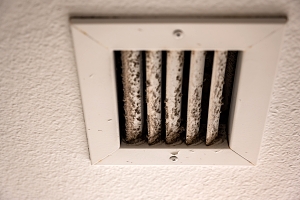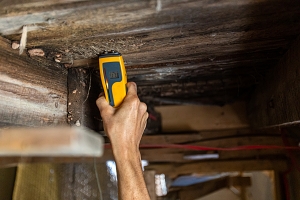Before purchasing a home, it’s crucial to inspect it thoroughly for potential points of water ingress, as moisture can lead to mold growth and compromise indoor air quality. Mold not only affects the structural integrity of the home but can also pose serious health risks to its occupants.
Lets delve into the various types of mold, the importance of professional inspections, and key areas to check for mold growth in your home.
Understanding Mold
 Mold is a common type of fungus that thrives in damp and humid environments. It comes in various types and colors, each with its own unique characteristics and health risks. From the fuzzy gray-brown alternaria to the musty blue penicillium and the notorious black mold, Stachybotrys chartarum, mold can manifest in different forms throughout your home.
Mold is a common type of fungus that thrives in damp and humid environments. It comes in various types and colors, each with its own unique characteristics and health risks. From the fuzzy gray-brown alternaria to the musty blue penicillium and the notorious black mold, Stachybotrys chartarum, mold can manifest in different forms throughout your home.
Each type of mold poses specific health risks, ranging from mild allergy symptoms to severe respiratory problems and other serious complications. Understanding the types of mold present in your home is crucial for effectively addressing mold-related issues and safeguarding the health of your family.
Identifying Mold in Your Home
Identifying mold in your home is crucial for maintaining a healthy indoor environment. Mold growth can occur in various areas of the house, particularly in damp and poorly ventilated spaces. Detecting mold early can prevent further spread and mitigate potential health risks associated with exposure.
Musty Odor
One common indicator of mold growth is the presence of a distinct musty odor. Mold emits volatile organic compounds (VOCs) as it grows, creating an unpleasant smell often described as musty or earthy. This odor may be particularly noticeable in enclosed spaces such as basements, bathrooms, and crawl spaces. If you detect a persistent musty smell in your home, it’s essential to investigate further for signs of mold.
Visible Signs of Mold
In addition to the characteristic odor, mold growth often manifests as visible patches or discoloration on surfaces. Common areas where mold may appear include walls, ceilings, window sills, and around plumbing fixtures. Mold can take on various colors, including black, green, or brown, depending on the species and environmental conditions. It may appear fuzzy, slimy, or powdery in texture. Regularly inspecting these areas for any signs of mold growth can help identify and address issues early on.
Common Mold Prone Areas
Certain areas of the home are more susceptible to mold growth due to factors such as moisture accumulation and inadequate ventilation. These include:
- Bathrooms: High humidity levels and poor ventilation make bathrooms prime breeding grounds for mold. Pay close attention to areas around showers, tubs, sinks, and toilets.
- Basements: Basements are prone to moisture intrusion from groundwater seepage, condensation, or plumbing leaks. Check for mold growth on walls, floors, and belongings stored in the basement.
- Attics: Poor attic ventilation can lead to moisture buildup, especially in climates with high humidity or temperature differentials. Inspect attic spaces for signs of mold on insulation, rafters, and sheathing.
- Crawl Spaces: Crawl spaces often have limited airflow and may be susceptible to moisture problems from ground moisture or plumbing leaks. Mold growth in crawl spaces can affect indoor air quality and spread to other areas of the home.
Prompt Action
Musty odors and visible patches of mold on surfaces are clear indicators of mold growth and should not be ignored. Prompt action is essential to prevent further spread and mitigate potential health risks. Addressing moisture issues, improving ventilation, and implementing proper mold remediation techniques can help eliminate mold growth and create a healthier indoor environment for you and your family.
Finding a Professional Home Inspector
When it comes to mold remediation, it’s essential to seek the expertise of a professional home inspector. A qualified inspector will conduct a thorough assessment of your property to identify any mold issues and provide comprehensive solutions for remediation.
Enlisting the help of a professional not only ensures the health and safety of occupants but also enhances the overall value of the property. By addressing mold-related issues proactively, you can mitigate potential health risks and preserve the integrity of your home for years to come.
Checking Points-of-Egress
Deteriorating flashing, cracks in windows, and poorly sealed doors can provide entry points for moisture, creating favorable conditions for mold growth. Regular inspections of these areas are essential for identifying potential issues and preventing mold problems.
By addressing structural vulnerabilities and maintaining proper ventilation, you can minimize the risk of moisture infiltration and subsequent mold growth. Investing in routine maintenance and repairs will help maintain indoor air quality and protect your home from the damaging effects of mold.
Regarding the Roof and Attic
The attic space and roof are prime locations for mold growth due to poor ventilation and potential water intrusion. Hiring a professional to inspect these areas is critical for identifying and addressing any underlying issues.
Improving attic ventilation and addressing roof leaks are essential steps in preventing mold growth in these areas. By addressing these concerns promptly, you can minimize the risk of mold-related problems and preserve the structural integrity of your home.
Avoiding the Musty Basement Smell
 Basements are particularly susceptible to mold growth due to their underground location and susceptibility to moisture infiltration. Cracks in the foundation, inadequate waterproofing, and poor ventilation can create ideal conditions for mold to thrive.
Basements are particularly susceptible to mold growth due to their underground location and susceptibility to moisture infiltration. Cracks in the foundation, inadequate waterproofing, and poor ventilation can create ideal conditions for mold to thrive.
Proper sealing, insulation, and moisture control measures are essential for preventing mold growth in basements. By addressing these factors and maintaining a dry environment, you can minimize the risk of mold-related issues and protect the health of your family.
Reach Out to Northern Virginia’s Mold Home Inspectors
Mold growth in the home is a serious issue that requires prompt attention to prevent health risks and structural damage. By understanding the types of mold, conducting regular inspections, and addressing moisture problems promptly, homeowners can maintain a healthy indoor environment and preserve the integrity of their homes. Remember, investing in professional inspections and remediation is key to ensuring a mold-free living space for you and your family.
Contact Dirt Connections today to connect with Northern Virginia’s premier mold home inspectors. Don’t wait until mold becomes a serious problem—schedule your inspection now to safeguard your home and family from potential health risks and structural damage. Our experienced team will provide thorough inspections and expert remediation solutions to ensure a mold-free living space for years to come.








































